Unlock your imagination and help Billy Collins find his vanished herd.
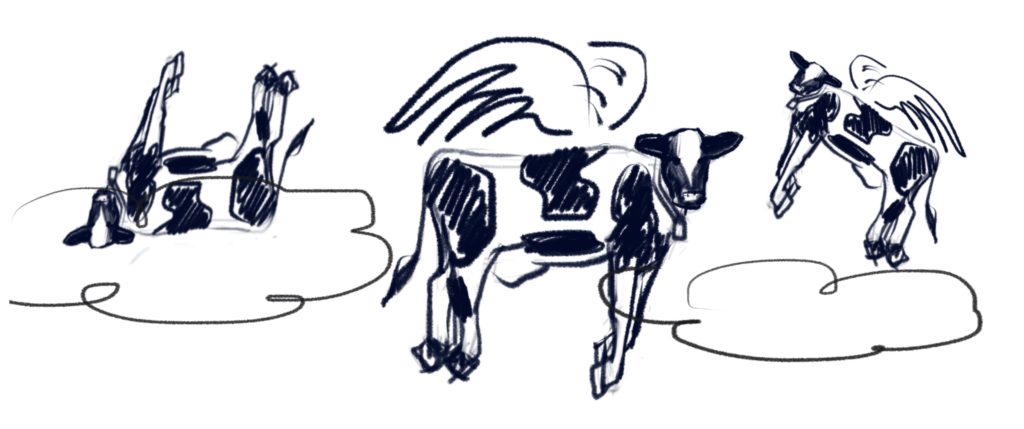
“Billy Collins is one of my favourite poets in the whole world.”
Carol Ann Duffy
Billy Collins has been dubbed America’s most popular poet; his distinguished career has garnered as many honours as it has spanned years. He has been, variously, a Literary Lion for New York Library in 1992, Poet Laureate of the United States from 2001 to 2003, and the New York State Poet from 2004 to 2006. He has been named a Senior Distinguished Fellow for Florida, sat on the editorial board of the Alaskan Review, and been on the advisory board of the Southern Review, among others. Born in 1941, he is still going strong almost eight decades later. He is probably as close to a celebrity as it is possible to be in the niche world of poetry, and can be credited with boosting the popularity of poetry through his accessible and enjoyable writing. He gets rave reviews from all quarters including luminaries such as Carol Ann Duffy who said, “Billy Collins is one of my favourite poets in the world.”
There were a few dozen who occupied the field across the road from where we lived, stepping all day from tuft to tuft, their big heads down in the soft grass, though I would sometimes pass a window and look out to see the field suddenly empty as if they had taken wing, flown off to another country. [blur] Then later, I would open the blue front door, and again the field would be full of their munching or they would be lying down on the black-and-white maps of their sides, facing in all directions, waiting for rain. How mysterious, how patient and dumbfounded they appear in the long quiet of the afternoon. [/blur] Please click here to read the poem in full. [blur] But every once in a while, one of them would let out a sound so phenomenal that I would put down the paper or the knife I was cutting an apple with and walk across the road to the stone wall to see which one of them was being torched or pierced through the side with a long spear. Yes, it sounded like pain until I could see the noisy one, anchored there on all fours, her neck outstretched, her bellowing head laboring upward as she gave voice to the rising, full-bodied cry that began in the darkness of her belly and echoed up through her bowed ribs into her gaping mouth. [/blur] Then I knew that she was only announcing the large, unadulterated cowness of herself, pouring out the ancient apologia of her kind to all the green fields and the grey clouds, to the limestone hills and the inlet of the blue bay, while she regarded my head and shoulders above the wall with one wild, shocking eye.
Despite these achievements, his writing can split opinion. He rarely writes in traditional form and eschews meter and rhyme, meaning his poems can often seem very simple. Sometimes people question how ‘poetic’ his poems are or wonder what the deeper meaning might be. His favourite topics are drawn from everyday experiences and can be very personal. He seldom addresses the ‘weighty themes’ associated with ‘proper’ poetry; his poems have titles such as I Chop Parsley While Listening to Art Blakey’s Version of Three Blind Mice and I Go Back to the House for a Book. His supporters argue – correctly in my opinion – that his poems are witty, humorous, straightforward and allow the reader to re-examine ordinary moments from life in a way that makes them important and vivid. He finds mystique and magic in the everyday – if Collins’ career has an overarching theme it might be that our lives are strange and miraculous. He likes to write about the moments we often overlook in the daily hustle and bustle, asking us to slow down for the time it takes to read a poem, and notice how even the most innocuous encounter – with parsley, a walk with his dog, a song, or even a cow – can have the power to move, bewilder, or remind us of the wonder of existence.
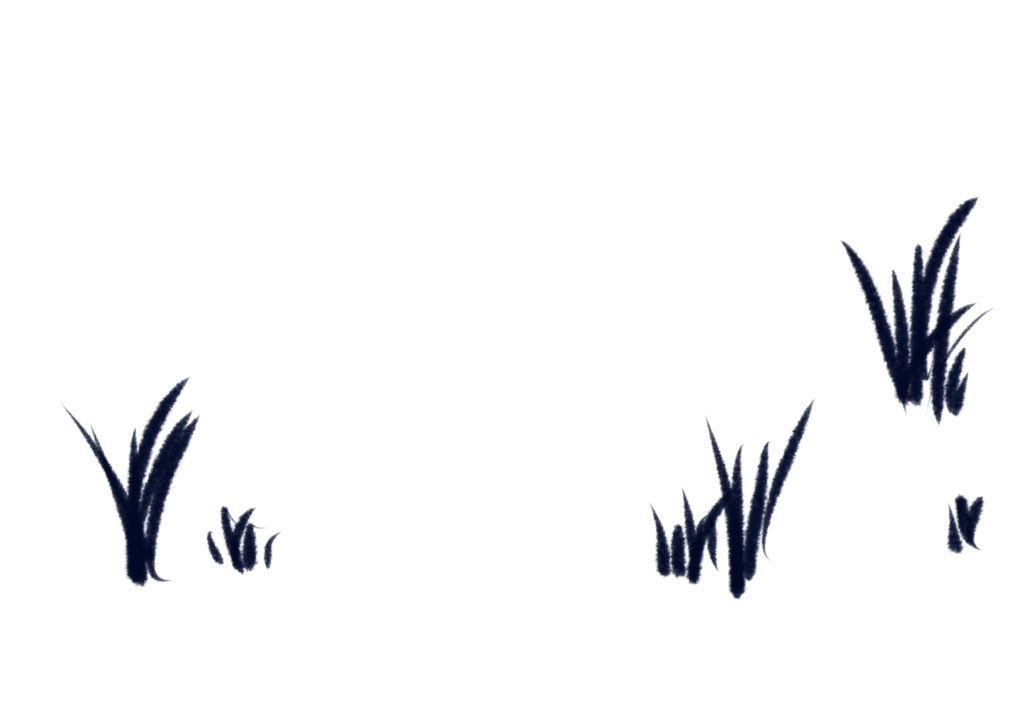
Given this, Afternoon with Irish Cows is typical Billy Collins. It seems to do nothing more than recount a simple experience of a man in a country cottage looking out for a familiar herd of cows. On the surface there is nothing special – but this is the whole point. Collins suggests that if we go through life with our eyes down, believing that everything is ordinary and nothing is special, then that’s how it will turn out; that kind of attitude tends to be self-fulfilling. On the other hand, if we take a moment to pause, look carefully and try to connect with our surroundings, we may be surprised at the discoveries we make. Collins was schooled by Wordsworth and Coleridge; he studied the English Romantics for his doctorate thesis. You can see their legacy in this poem, which can be placed in the literary tradition of pastoralism (think Wordsworth’s Daffodils) in which contemplation of natural scenes can bring about joy, serenity or enlightenment.
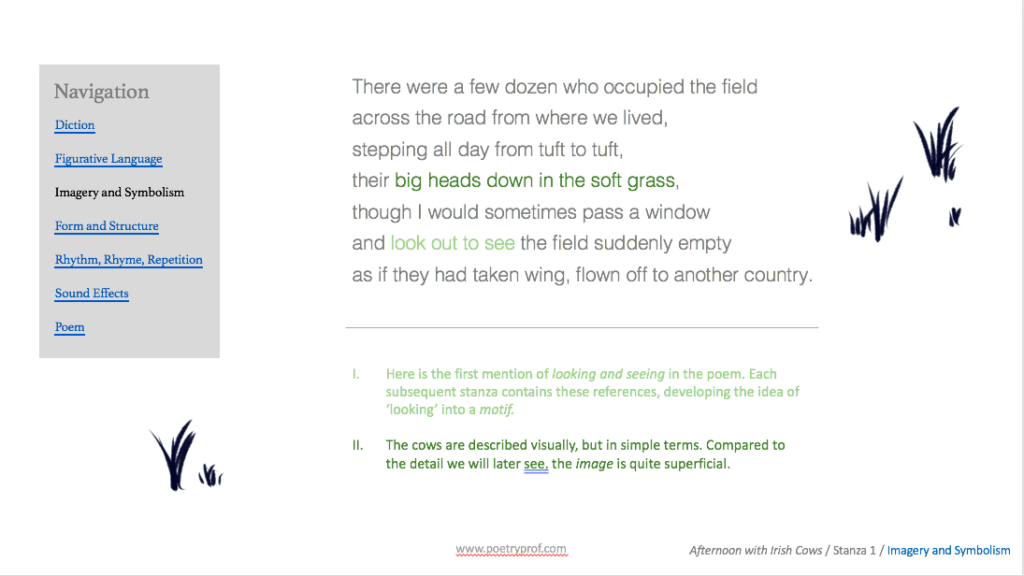
Begin reading this poem by following Collins’ advice: look carefully. You should notice there is a mention in every verse of ‘looking’ and ‘seeing’. Stanza 1 gives us the viewpoint of the speaker as he stands in his kitchen: “I would sometimes pass a window and look out to see the field suddenly empty”. In the second stanza the word appears is connected to looking and seeing. In the third stanza the speaker walks across the road to see and in the fourth he could see the noisy one. The final stanza contains the word regarded. Importantly, through persistent ‘looking’, the speaker comes to see things he couldn’t see before. At first he can’t see the cows from his window, which provides only a narrow view of the world. By going outside, his view is widened. He thought the cows were hurt (it sounded like pain), but by looking carefully he realises they are not. In the final stanza the word ‘see’ is replaced by the word ‘know’ (Then I knew that she was only announcing the large, unadulterated cowness of herself). Collins is suggesting that by taking the time to look, and allowing yourself to follow where curiosity leads, you will find knowledge and truth.
It’s worth spending a moment looking at the descriptions of the cows here. Our speaker begins with ordinary diction: munching, stepping, big heads. All pretty plain and obvious words. But the more he looks, the more he sees, and the descriptions become progressively grander and more poetic. Just listen to that throaty bellow again:
…her bellowing head
laboring upward as she gave voice
to the rising, full-bodied cry
that began in the darkness of her belly
and echoed up through her bowed ribs into her gaping mouth.
Through imagination, he is able to move beyond the surface appearance of the cows and visualise their inner lives (patient and dumbfounded, waiting for rain): he is able to imagine the journey of the cow’s bellow: from the darkness of her belly; to her bowed ribs; into her gaping mouth. The diction has moved from ordinary to extraordinary: munching to bellowing; stepping to anchored there on all fours; big heads to gaping mouth.
Collins’ suggests that looking prompts action. The whole ‘journey of discovery’ began because he looked out the window and couldn’t spot the few dozen cows who normally sit in the field – why? Where did they go? The speaker’s curiosity is aroused. Therefore, the simple act of looking prompts a chain of actions: first he looks out; then he opens the blue front door; then he put down the paper or the knife; then he crosses the road. Each action is small and seems unimportant, but chain them together and they represent a journey into the unknown. The idea of a ‘journey of discovery’ is suggested by the form of the poem. Each stanza is one sentence only so one line enjambs to the next. Enjambment conjures a journey’s sense of movement and flow as the poem is read. Splitting the poem into five equal stanzas reinforces the idea of stages on a journey, where the lack of rhyme scheme or meter gives it a certain unpredictability.
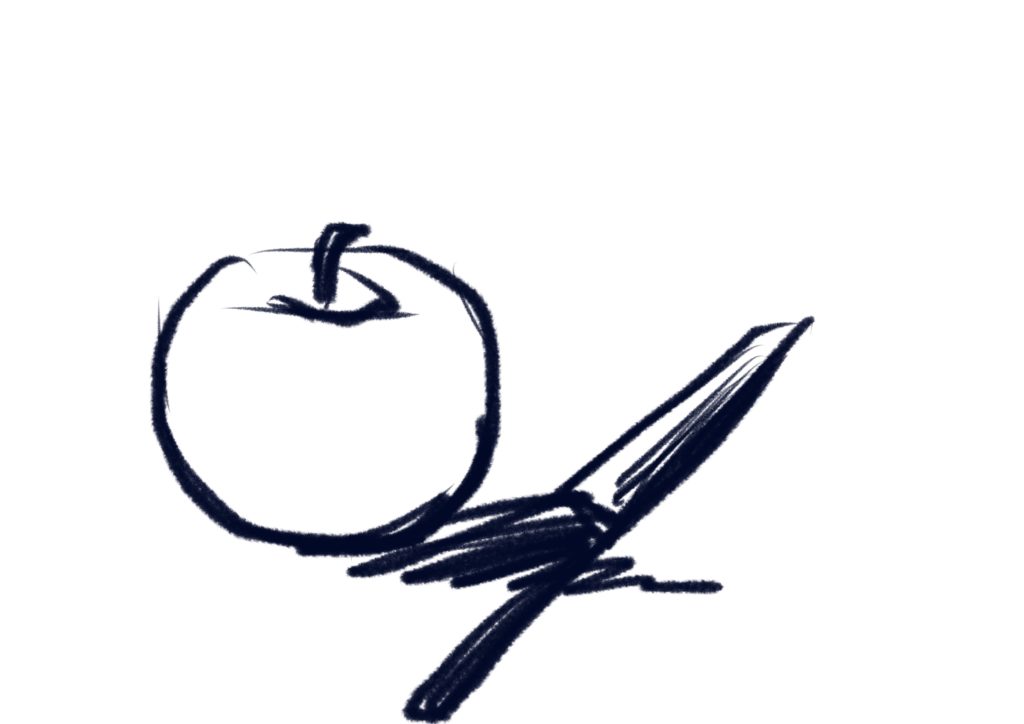
Think of his kitchen as the ‘ordinary world’ in which he lives an ordinary life. Objects inside the kitchen are ordinary and actions are mundane: cutting up an apple, reading the paper. The field outside represents a ‘special world’ free from the constraints of ordinary life. Outside, anything can happen, even impossible things like flying cows! The window and door are passages and the stone wall a barrier between the known and unknown worlds. Therefore, stepping outside represents taking a leap of imagination. This is expressed through figurative language. Notice how all the metaphors in the poem are about the cows who live in the ‘outside’ world: they grow wings and fly away; their bodies are black and white maps; the speaker imagines them on fire (torched) or pierced through the side by a long spear.
As in much of Collins’ poetry his diction mystifies the ordinary world. Words such as mysterious, phenomenal and darkness are drawn from the semantic field of ‘mystery’. The outside world is vividly coloured: black, white, blue, green and grey, suggesting that the wider world is vivid, colourful, full of excitement. The special properties of the door are also signified using the colour blue. You might ask: if it’s so much fun outside, why don’t we all just go there? Don’t be so hasty – Collins suggests that fear of the unknown is the reason we confine ourselves to predictable and mundane lives. Flying off to another country and following maps express a desire to break free and explore; but the painful images of cows on fire or being stabbed create fear and danger in the outside world.
Ultimately, though, those fears are shown to be misplaced. At the end of the poem, Collins drops any use of figurative language. You can see the green fields and the grey clouds, the limestone hills and the inlet of the bay quite clearly. By overcoming fear of the unknown, we are rewarded with quite a sight. Our horizons have, quite literally, broadened. As for the mysterious cow? Of course it’s just a cow, no wings or flames – but what a cow; large and unadulterated. Collins reminds us that imagination is a fundamental component of knowledge; it helps us to see the world in fresh and powerful ways.
One of Collins’ signature moves is saving a final thought till the very end of his poems. This hearkens back to the poetic tradition of the volta or ‘turn’ which means a sudden shift in the poet’s argument or point of view. In the last two lines of this poem, Collins performs his shift, switching the perspective to have the cow look back at us: “while she regarded my head and shoulders above the wall with one wild, shocking eye.” Just as Collins’ speaker was curious about the cow, she too was curious about the strange creature that popped it’s head over her wall! This little twist creates an empathetic connection with the cow. The end of the poem is a reminder that we are not the only creatures with complex inner lives: our own fears stare back at us from the wild, shocking eye of the cow.
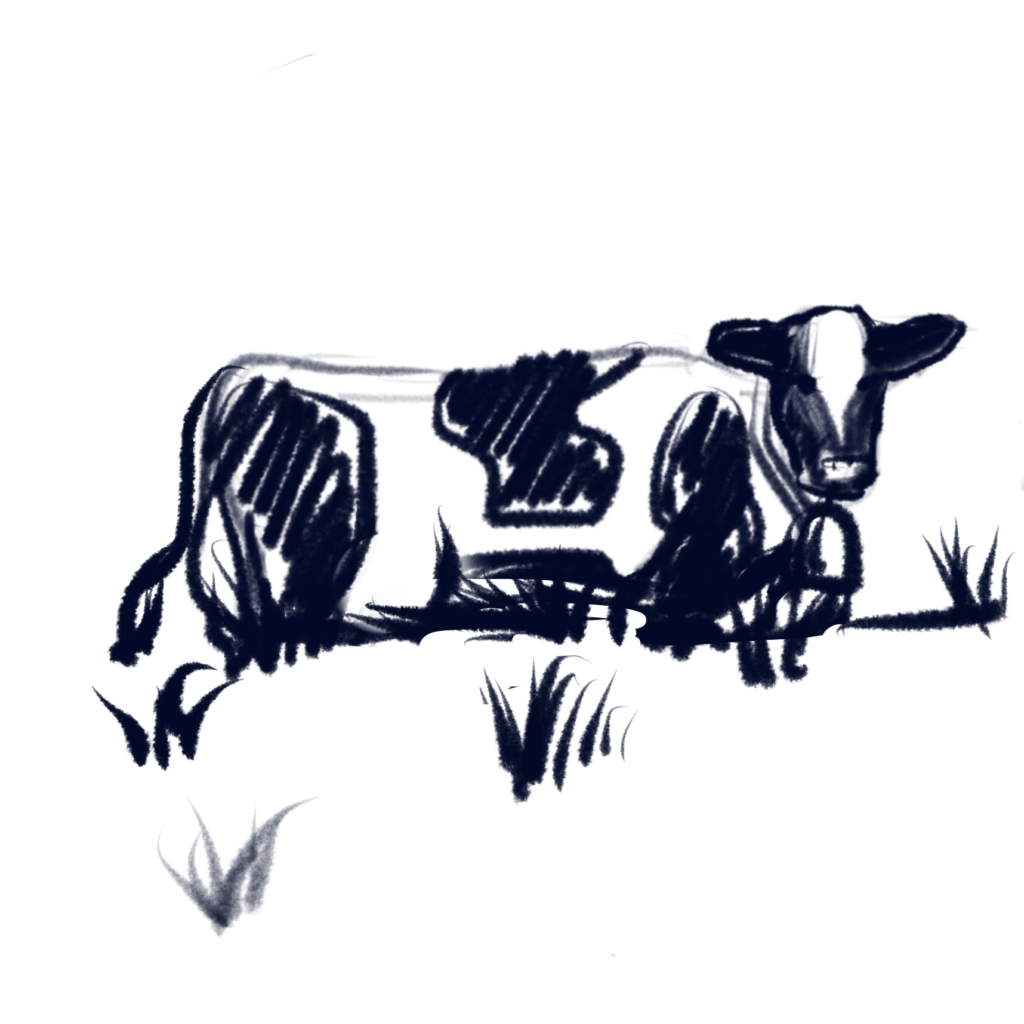
Suggested poems for comparison:
- The Thought-Fox by Ted Hughes
Hughes is one of the masters when it comes to reminding us that animals are complex, mysterious and worthy of deep reflection. In this poem, the quick, darting movements of a fox inspire poetry that is similarly elusive. Like Collins’ Irish Cows, contemplation results in the unchaining of imagination.
- Japan by Billy Collins
This is a rare Billy Collins poem written in form: each stanza comprises its own haiku. It’s also got a lovely shift in tone at the end, a subtle variation on the traditional poetic volta.
- Horses by Edwin Muir
In this powerful and mysterious poem, horses are re-imagined as incredible engines symbolising the growth of industry.
- I Wandered Lonely As a Cloud by William Wordsworth
The pastoral poem you’ve probably heard of and can even recount the first few words: “I wandered lonely as a cloud…”
- The Tyger by William Blake
Symbolic animals are common in Blake’s poetry, which he illustrated with his own hand-drawn illustrations as well.
Additional Resources
If you are teaching or studying Afternoon with Irish Cows at school or college, or if you simply enjoyed reading this analysis and would like to discover more, you might like to take a look at our bespoke study bundle for this poem. The whole bundle costs only £2, and includes:
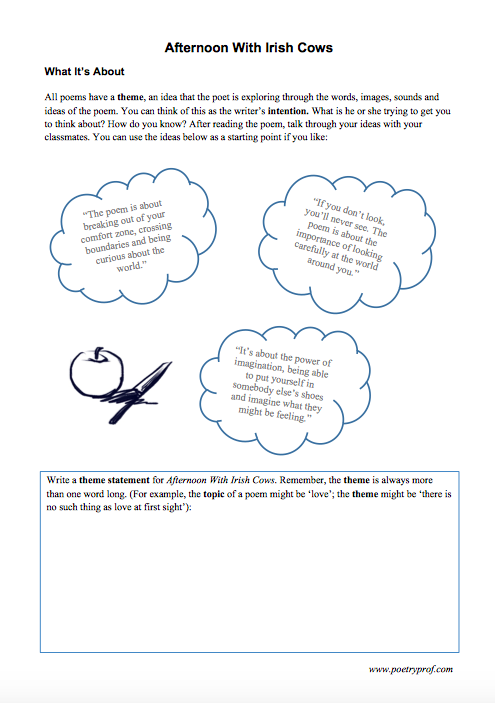
- 4 pages of activities that can be printed and folded into a booklet for use in class, at home, for self-study or revision.
- Study Questions with guidance on how to answer in full paragraphs.
- A sample Point, Evidence, Explanation paragraph for essay writing.
- An interactive and editable powerpoint, giving line-by-line analysis of all the poetic and technical features of the poem.
- An in-depth worksheet with a focus on how Billy Collins uses metaphor and simile in this poem.
- A fun crossword-quiz, perfect for a recap lesson or revision.
- 4 practice Essay Questions – and one complete model Essay Plan.
And… discuss!
Do you agree with this interpretation of Afternoon With Irish Cows? What did you think about the ending? Do you have another idea that wasn’t mentioned here? Write your ideas in the comments section and see what other readers think. And, for daily nuggets of analysis and all-new illustrations, don’t forget to find and follow Poetry Prof on Instagram.
You are incredible! These in depth analyses are single-handedly getting me through revision for IGCSE mid year exams. Thank you so much 🙂
Hi Lynnie,
Thank you for your kind comment – I’m really happy you enjoy the blogs. Best of luck in your mid-year exams!
What does Afternoon with Irish Cows Billy Collins’ poetry books belong to? Thanks